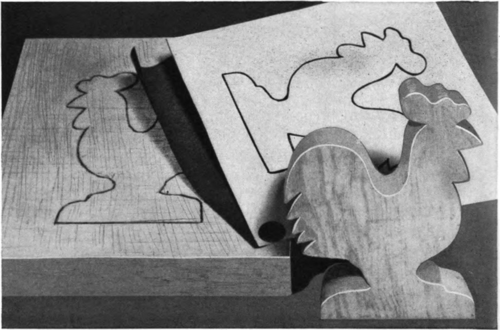Woods and Tools For Whittling
Description
This section is from the book "Let's Whittle", by LeRoy Pynn, Jr.. Also available from Amazon: Let's Whittle.
Woods and Tools For Whittling
Woods
Softwood is the best for whittling. Clear white pine-Wisconsin and Michigan, California sugar, and Western (Ponderosa) give the most satisfactory results.
Aromatic red cedar and redwood also are excellent woods with which to work, while in the hardwoods black walnut, mahogany, red gum, and maple may be used.
Care should be taken to select wood free from knots or cross grain, although a skillful whittler can use a beautifully grained cabinet wood to emphasize the character of the subject. This is tricky, however. Clear, soft, straight-grained wood will yield better results at first.
Be sure that the grain of the wood is used in such a way that thinner portions of the carving, such as the legs of a deer or trunk of an elephant, are not weakened. The grain must at all times run parallel with fragile, extended portions.
You will find, after you have worked with different patterns, that it is almost impossible to work the grain in all positions. For instance, a pointer dog has a thin tail and rather slim legs. The solution to this problem is to get the legs grained right and then to drill and plug in a tail with a long grain. When fitted correctly, the splice will not show.
Tools
Whittling requires a sharp knife-either a jackknife or one of the precision-made hobby knives with assorted blades-a piece of wood, an oilstone, a coping or band saw, and an idea.
It is most important that the knife blade be razorsharp. Sharpen the edge by drawing the blade back and forth over the stone. When you think it is sharp enough, test it by drawing the blade through the cross grain. If it cuts clean, go ahead; if not, keep at the sharpening until your cuts are clean.
The Knife
Remember there is always more danger of cuts from a dull knife than from a sharp one, because the dull knife is more likely to slip.
While whittling, hold the knife firmly. For a short time, your hands will tire, but this will be overcome. If blisters form at the points of pressure, protect the spots by the use of adhesive tape.
Cutting to Shape
Although a knife will whittle down any sizable piece of wood much time can be saved and wear and tear on the knife lessened by the use of a coping or band saw to cut the outline to the required shape.
Transfer To Wood
To transfer a pattern to wood, select the project you intend to make; trace the outline drawing with thin tissue paper; find the correct size of wood to allow for the correct direction of the grain. Place carbon paper between the pattern and the wood block and trace the pattern onto the wood through the carbon. Figure 1.

Figure 1
From this point, it is a simple matter to cut the block to pattern shape. If you use a handsaw, try to hold the saw in straight position, in order that both sides of the blank will be equally thick.
Continue to:


